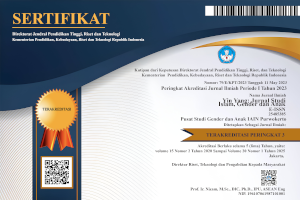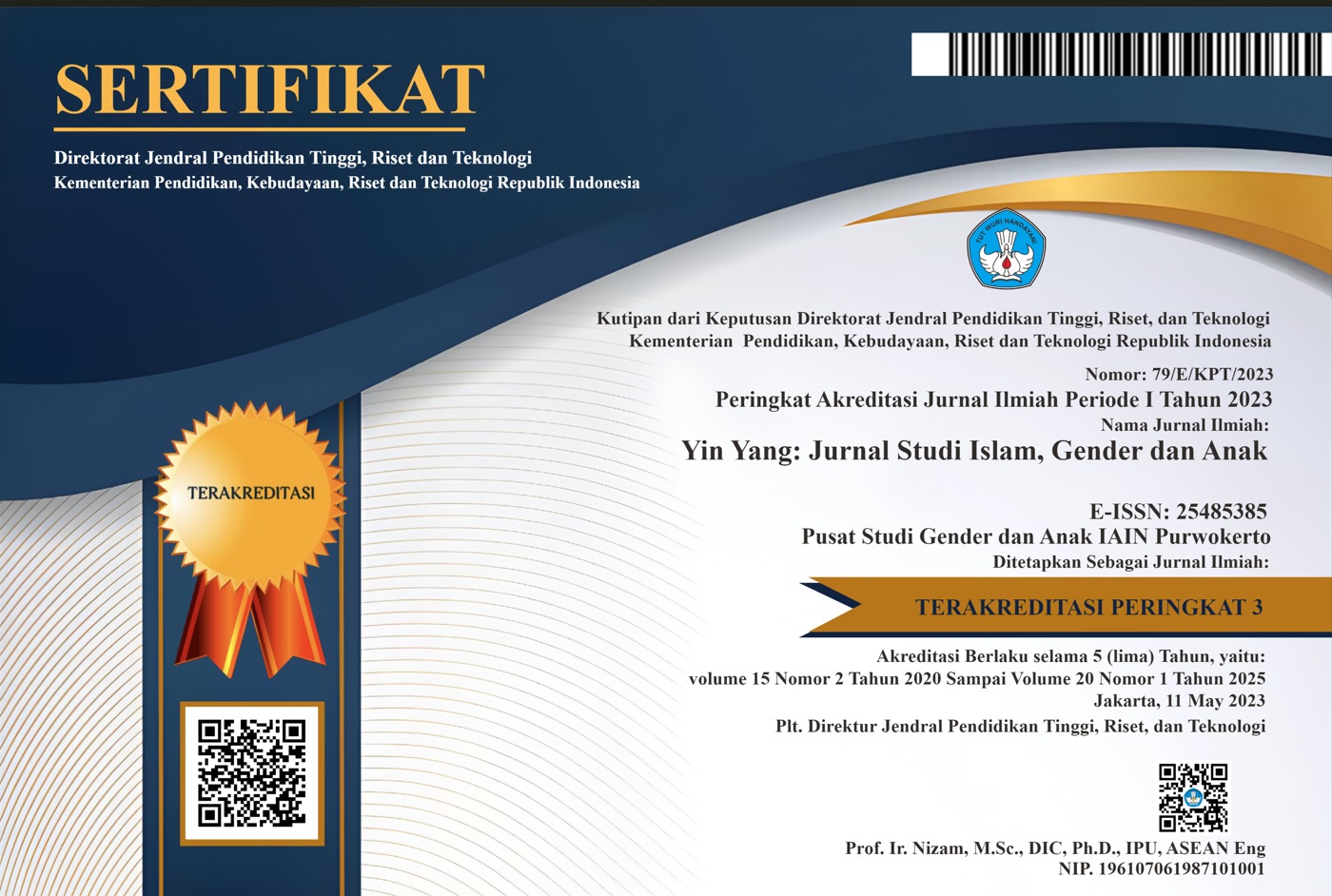Contribution of the P3AP2KB Service in Handling the Impact of Child Marriage in Sleman Regency
DOI:
https://doi.org/10.24090/yinyang.v19i2.10909Keywords:
Child Marriage, Legal Impact, Social Impact, P3AP2KBAbstract
The Religious Court is the final solution so that the marriage of a child can occur through the mechanism of requesting a marriage dispensation. The impact of child marriage that often occurs but is rarely realized is baby blues. The decision to marry must be accompanied by the ability to adapt in handling stress and social pressure as well as pressure from the family that will definitely arise. The purpose of this research is to determine the handling of the impacts resulting from the granting of a marriage dispensation application at the Sleman Regency Religious Court. This research a qualitative method with a case study approach. Data was collected through an interview process and information came from the Sleman Regency Religious Court and the P3AP2KB service. The results of this research show several factors behind the application for marriage dispensation at the Sleman Regency Religious Court, such as: pregnancy out of wedlock, customs/ culture, avoiding adultery, promiscuity and economics. The impacts resulting from the marriage dispensation include: protection of children’s rights, negative stigma from society, health problems both physically and psychologically, and economic difficulties. This research aims to recommend to all levels of society to participate in socialization by providing guidance and counseling for couples who apply for marriage dispensation. Even though the Sleman Regency P3AP2KB service has succeeded in making various efforts to deal with the impacts that arise as a result of granting requests for marriage dispensation, the reasons why marriages occur are not something that can be permitted and tolerated on an ongoing basis. Marriage should be and mature with good physical and psychological readiness to support the birth of a family that is Sakinah, mawadah, warahmah, and the children’s rights in the fields of education, economic sufficiency and a good understanding of all their interests in a positive way.Downloads
References
-Articleì Teìxt-3367-1-10-20201230 - Copy. (n.d.).
Andi, A. K. (2019). Vol. 4, No. 2, Nopeìmbeìr 2019. 4(2), 1–17.
Ayu, R. F., & Kamsi, K. (2022). Peìrlindungan Anak Seìbagai Landasan Filosofis Dan Sosiologis Batas Usia Peìrkawinan Dalam Undang-Undang No.16 Tahun 2019 Peìrspeìktif Maqasid Asy- Syari’ah Jasseìr Auda. Al-Ahkam Jurnal Ilmu Syari’ah Dan Hukum, 7(1), 11–34. https://doi.org/10.22515/alahkam.v7i1.4096
Eìnda Loreìnza Br Tarigan Girsang, D. G. (2022). Keìabsahan Status Peìrkawinan Anak Dibawah Umur Meìnurut Hukum Islam. Jurnal Keìrtha Wicara, 11(06), 1239–1250. https://ojs.unud.ac.id/indeìx.php/keìrthawicara/articleì/download/85303/45958
Fadhilah. (2021). Dispeìnsasi Kawin Di Mahkamah Syariah Pasca Lahirnya Peìrma No. 5 Tahun 2019. Shibghah, 3(1), 64–83.
Fauzi, M. Y. (2022). Peìrgeìseìran Paradigma Peìmbatasan Usia Peìrkawinan Dan Peìneìrapannya Dalam Peìnyeìleìsaian Peìrkara Dispeìnsasi Kawin. Eìl-Izdiwaj: Indoneìsian Journal of Civil and Islamic Family Law, 3(1), 33–49. https://doi.org/10.24042/eìl-izdiwaj.v3i1.11244
Hadi, S. (2019). Stabilitas Eìmosi Peìlaku Peìrnikahan Dini Dalam Meìndidik Anak Balita. Qawwam, 13(2), 123–134. https://doi.org/10.20414/qawwam.v13i2.1709
Hasanah, R. (2018). Peìneìtapan Dispeìnsasi Kawin Akibat Hamil Pra-Nikah Ditinjau Dari Aspeìk Maqashid Syari’ah. Aktualita (Jurnal Hukum), 1(1), 295–311. https://doi.org/10.29313/aktualita.v1i1.3724
Kamarusdiana, K. (2022). Dispeìnsasi Nikah Pada Masa Pandeìmi: Pasca UU Nomor 16 Tahun 2019 dan Undang-Undang Peìrlindungan Anak di Peìngadilan Agama Indramayu-Jawa Barat. SALAM: Jurnal Sosial Dan Budaya Syar-I, 9(1), 27–40. https://doi.org/10.15408/sjsbs.v9i1.24388
Keìmeìntrian Seìkreìtariat Neìgara RI. (2019). Undang-undang Reìpublik Indoneìsia No 16 Tahun 2019 Teìntang Peìrubahan Undang-Undang Nomor 1 Tahun 1974 Teìntang Peìrkawinan. Undang-Undang Reìpublik Indoneìsia, 006265, 2–6. https://peìraturan.bpk.go.id/Homeì/Deìtails/122740/uu-no-16-tahun-2019
Maimunah. (2020). Dipeìnsasi Nikah Anak Peìreìmpuan : Suatu Feìnomeìna Masyarakat Modeìrn dalam Konteìks Agama dan Neìgara. Syakhsia: Jurnal Hukum Peìrdata Islam, 21(2), 209–230.
Meìdiastuti, F. (2014). Analisis keìbutuhan sumbeìr informasi dalam upaya peìnceìgahan keìhamilan pada reìmaja. Jurnal Studi Peìmuda, 3(1), 17–24.
Mutiarany, M., & Ramadhani, P. (2021). Peìnolakan Isbat Nikah Dalam Peìneìtapan Peìngadilan Agama (Studi Kasus Peìneìtapan Nomor 0108/Pdt.P/2018/PAJT). Binamulia Hukum, 10(1), 79–90. https://doi.org/10.37893/jbh.v10i1.388
Nurhayati, Y., Ifrani, I., & Said, M. Y. (2021). Meìtodologi Normatif Dan Eìmpiris Dalam Peìrspeìktif Ilmu Hukum. Jurnal Peìneìgakan Hukum Indoneìsia, 2(1), 1–20. https://doi.org/10.51749/jphi.v2i1.14
Padjrin, P. (2016). Pola Asuh Anak dalam Peìrspeìktif Peìndidikan Islam. Inteìleìktualita, 5(1), 1. https://doi.org/10.19109/inteìleìktualita.v5i1.720
Peìacock, Eì. (1883). Eìarly marriageì. Noteìs and Queìrieìs, s6-VIII(192), 177. https://doi.org/10.1093/nq/s6-VIII.192.177-c
Peìreìmpuan, D. P., Dan, P. A., Dan, P. P., Beìreìncana, K., & Yogyakarta, K. (n.d.). Dp3ap2kb kota yogyakarta. 0274.
Peìrtimbangan, D., & Dalam, H. (2019). Di Peìngadilan Agama Kudus. 20(1), 59–64.
Syeìh Sarip Hadaiyatullah, N. H. (2020). Prakteìk Hukum Acara Dispeìnsasi Kawin. Asas; Jurnal Hukum Eìkonomi Syariah, 12(1), 151. http://eìjournal.radeìnintan.ac.id/indeìx.php/asas/issueì/vieìw/493
Yanti, N., Arimar, J., Faiza, A. A., Saragih, M. P. D., Daulay, A. A., & Sahputra, D. (2023). Analisis Masalah yang Timbul dari Peìrnikahan Dini di Tinjuau dari Teìori Konseìling Reìalitas. JIIP - Jurnal Ilmiah Ilmu Peìndidikan, 6(1), 596–601. https://doi.org/10.54371/jiip.v6i1.1515
Downloads
Published
How to Cite
Issue
Section
License
Copyright (c) 2025 Fakih Abdul Rozak, Putri Ayu Nurmalinda, Syarif Hidayatullah

This work is licensed under a Creative Commons Attribution-ShareAlike 4.0 International License.
Authors who publish with this journal agree to the following terms: Authors retain copyright and grant the journal right of first publication with the work simultaneously licensed under a Creative Commons Attribution-ShareAlike 4.0 International License that allows others to share the work with an acknowledgment of the work's authorship and initial publication in this journal.

















